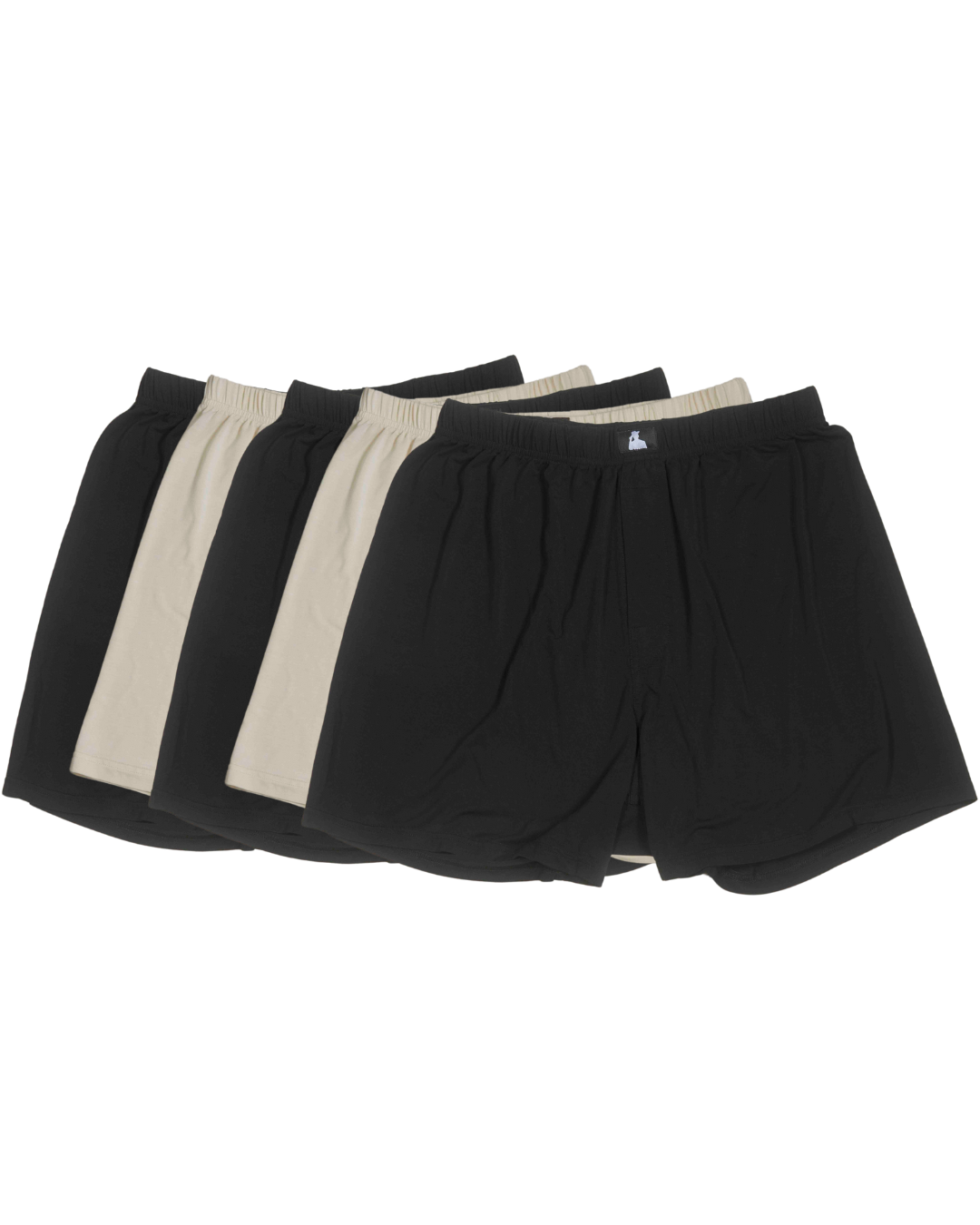Fertility Underwear for Men: What It Is and Why It Matters
Written By The Mr. Fertyl Research & Education Team
Fertility-safe underwear is more than just a trend – it’s a proactive choice for men who care about reproductive health. Conventional underwear can expose you to excess heat, toxins, and even microplastics that may negatively impact sperm count and quality. Fertility underwear made from non-toxic, breathable, heat-regulating fabrics (like Bamboo Lyocell) helps keep things cool and chemical-free. In this post, we’ll explain how everyday factors like fabric and temperature affect sperm health, why sperm counts have been declining worldwide, and how switching your boxers could make a real difference. We’ll also highlight what makes Mr. Fertyl’s Bamboo Lyocell underwear special for health-conscious, fertility-focused men.
The Hidden Impact of Everyday Underwear on Sperm Health
You might be wondering: can something as simple as underwear really affect male fertility? Surprisingly, yes. Research over the past few decades has revealed that various environmental factors – including heat and toxins – can influence sperm production. In fact, global sperm counts have fallen by over 50% in the last 50 years [1], and many experts suspect lifestyle and environment are key culprits [7].
One often-overlooked factor is the underwear you wear every day. Heat is a known enemy of sperm – the testicles hang outside the body for a reason, needing to stay a few degrees cooler than core body temperature for optimal sperm production [6][10]. Tight, non-breathable underwear can trap heat against your groin, creating a mini-“sauna” for your testicles. Overheating the scrotum (for example, with frequent sauna use or very snug underwear) can impair sperm count and function [6]. It’s no wonder fertility specialists often recommend wearing loose-fitting underwear to men trying to conceive. The UK’s National Health Service explicitly advises men to “wear loose fitting underwear – tight underwear can increase the temperature of your testicles which may affect the quality of your sperm.” [3]
Beyond heat, everyday fabrics and chemicals in your clothing may expose you to substances that don’t do your fertility any favors. Many synthetic fabrics (like polyester or nylon) are derived from petrochemicals and can contain additives or dyes that are potential endocrine-disrupting chemicals (EDCs). EDCs interfere with hormones and have been linked to reproductive issues in both men and women [11]. For instance, phthalates (used to soften plastics) and benzophenone-2 (a chemical in some fabric dyes and UV blockers) have been shown to primarily affect male fertility [11]. Some water-resistant or stain-proof clothes use “forever chemicals” (PFAS), which can leach into our bodies and are associated with reduced fertility and hormonal disruption [11]. And remember, these chemicals don’t have to be ingested to cause exposure – they can enter your body through skin contact [11]. Wearing fabric that is infused with toxins right against such a sensitive area, day in and day out, is probably not something most men would choose if they knew the risks.

Cool. Clean. Fertyl.
Discover Mr. FertylToxins and Microplastics: A Growing Concern
Modern environmental pollutants are another piece of the puzzle. You’ve probably heard about microplastics – tiny plastic particles found everywhere from oceans to drinking water. Disturbingly, scientists have started finding microplastics in human tissues – including men’s reproductive organs [2]. A 2023 study even detected microplastic particles in human testis and semen [2], and researchers are concerned that microplastics may be contributing to male fertility issues [2]. These particles often come from the breakdown of larger plastics, and one source is synthetic clothing fibers. Every time you wash that cheap polyester underwear or athleisure wear, microscopic fibers shed into the water – some of which we ingest or which may even be absorbed through the skin. Over time, the buildup of such substances could negatively impact sperm development [2].
It’s not just microplastics; other environmental toxins can also sneak into our lives via clothes. Heavy metals and residues from pesticides can be found in some fabrics or dyes [6]. Long-term exposure to pesticides or heavy metals like lead and cadmium is known to cause infertility in men [6]. The reality is that our clothing – especially if not made with health in mind – might be a source of exposure to substances that lower sperm quality.
Heat: Keeping the “Family Jewels” Cool
Now, let’s talk more about heat. Every guy has heard the old boxers vs. briefs debate. Well, it’s not just an urban legend. Looser underwear tends to keep the testicles cooler, which can benefit sperm production. A notable Harvard study in 2018 found that men who usually wore boxer shorts had significantly higher sperm concentrations and total counts than men who wore tight briefs [4]. How much higher? According to one news report on the study, loose-fitting boxers were linked to 25% more sperm on average compared to tight underpants [5]. The reason is simple: snug briefs hold the testicles closer to the warm body and restrict air flow, raising scrotal temperature. In contrast, boxers let things breathe and help keep testicular temperature at an optimal level for sperm production [3][5].
Extreme as it sounds, fabric type can also make a difference. In fact, researchers once investigated polyester underwear as a form of male contraception. In a 1992 study, a group of men wore a polyester sling around their scrotum 24/7 – and after about 3-4 months, all of them developed azoospermia (zero sperm count) [9]. The men’s sperm production recovered after they stopped wearing the sling, confirming that the effect was reversible [9]. The scientists theorized that the polyester fabric created extra heat (and possibly static electricity) that dramatically suppressed sperm production [9]. While no one is suggesting your everyday underwear is as intense as a polyester fertility sling, this study is a eye-opening reminder: hot, synthetic fabrics are the last thing your swimmers need.
Everyday life gives us plenty of heat challenges already – from sitting with a warm laptop on your lap to spending time in hot tubs or long car rides with heated seats. So, your choice of underwear should ideally counteract those heat stressors, not add to them. As one urologist bluntly put it, “Heat is not kind to sperm” [7]. Choosing breathable, cooler undergarments is a simple way to protect those precious little cells.
What Is Fertility Underwear and How Is It Different?
All this leads to the concept of fertility underwear. It’s not a magical medical device or a gimmick – it’s basically underwear designed with your reproductive health in mind. Fertility-safe underwear focuses on materials and construction that foster a sperm-friendly environment (cool, non-toxic, and comfortable). Here are the key features that set fertility underwear apart from your standard 6-pack of fashion briefs:
- Breathable, Heat-Regulating Fabric: Fertility underwear uses fabrics that allow airflow and disperse heat. By preventing heat buildup, they help keep your testicles at a healthy temperature. For example, Bamboo Lyocell – the fabric used in Mr. Fertyl’s underwear – is known for being highly breathable and moisture-wicking, which helps regulate temperature and keep you cool and dry. Unlike thick synthetics, this kind of fabric won’t turn your groin into a greenhouse on warm days.
- Non-Toxic Materials: A major plus is using natural or sustainably-produced fibers that are free from harmful chemicals. Bamboo Lyocell is produced in a closed-loop process using non-toxic solvents, and it doesn’t require harsh pesticides to grow the raw bamboo. This means the fabric itself is gentle on your skin and unlikely to contain residue of endocrine disruptors or “forever chemicals.” You can wear it directly against your body without worrying that you’re absorbing invisible toxins. (Remember, as mentioned earlier, chemical exposures via clothing are a real thing – so a clean, chemical-free fabric is a big win for your health [11].)
- Comfort and Support (Without Compression): Fertility underwear is typically designed to be supportive enough for daily comfort but not overly tight or binding. The goal is to promote healthy circulation and avoid squeezing the testicles against the body. The fabrics used (like soft bamboo-derived lyocell or organic cotton) tend to be gentler on the skin, reduce sweating, and prevent chafing. All of this adds up to a more hospitable environment for sperm. After all, happy testicles are productive testicles!
- Eco-Friendly and Sustainable: Men who care about fertility often care about overall wellness – and that includes the environment. The good news is fertility-friendly fabrics like Bamboo Lyocell are also eco-conscious choices. Bamboo is a fast-growing, renewable resource that doesn’t need fertilizers or excessive water, and the lyocell manufacturing process has a low environmental impact (recycling 99% of water and solvents). By choosing these underwear, you’re not just doing something good for your body, but also for the planet. And fewer synthetic materials in your underwear means less shedding of microplastics in the wash, which is a small yet meaningful step for environmental health.
In short, “fertility underwear” is about ticking all the boxes that conventional underwear misses. Mr. Fertyl’s Bamboo Lyocell underwear, for instance, check each of these boxes – they’re non-toxic, breathable, cooling, comfortable, and eco-friendly. They look and feel like premium everyday underwear, but they’re purpose-built to create an ideal home for sperm. Think of it as giving your swimmers the five-star treatment they deserve.
Why It Matters (Especially If You’re Trying to Conceive)
You might be thinking: Is switching underwear really going to make me more fertile? The honest answer is that fertility is multifactorial – no single change is a silver bullet. However, when you’re trying to conceive or even just safeguarding your reproductive health for the future, eliminating avoidable risks can significantly stack the odds in your favor. Wearing fertility-friendly underwear is a simple lifestyle tweak that addresses multiple risk factors at once: it reduces unnecessary heat exposure, limits contact with harmful chemicals, and supports overall comfort and hygiene. It’s essentially giving your body one less thing to worry about, so it can focus on producing healthy sperm.
Importantly, taking care of sperm health is not just about having babies – it’s part of caring for your general health too. Low sperm count or poor sperm quality can sometimes be a sign of other health issues or imbalances. By choosing habits (and clothing) that support fertility, you’re often supporting hormonal balance and wellness in general. Plus, many men report that breathable, natural-fiber underwear simply feels better during the day – no more swampy, constricted feeling. So the benefits can be immediate (improved comfort) as well as long-term (improved fertility).
If you and your partner are actively trying for a baby, it’s worth doing everything reasonably possible to boost your chances. We routinely advise women to take prenatal vitamins and avoid certain toxins when trying to conceive; think of this as the male equivalent. Switching from synthetic, tight underwear to a fertility-conscious brand is a proactive step you can take without any downside. It’s not invasive, it’s not expensive compared to high-tech fertility treatments, and it might help nurture better semen parameters over the critical months of attempting pregnancy.
And let’s clear up a common misconception: sometimes men turn to trendy supplements or hormone boosters in hopes of increasing fertility, but those can backfire. For example, you may have seen products aimed at “boosting testosterone.” The irony is that taking testosterone supplements actually lowers your sperm count by suppressing your body’s natural sperm production [7]. In contrast, fertility underwear isn’t about altering your hormones or pushing your body in unnatural ways – it’s about creating healthier conditions for the biology you already have. Along with other doctor-recommended lifestyle changes (like eating a balanced diet, exercising, limiting alcohol, and not smoking), improving your choice of underwear can be part of a holistic approach to maximizing your fertility potential [7].

Comfort Meets Fertility.
Upgrade TodayThe Bottom Line
Male fertility is a delicate thing, influenced by factors ranging from the air we breathe to the clothes we wear. The concept of fertility underwear for men might sound novel, but it boils down to simple science: keep it cool, keep it clean (non-toxic), and keep it comfortable. Traditional underwear – especially cheap, synthetic, tight varieties – often fails on those fronts by overheating the testicles or introducing undesirable chemicals. Over time, that can contribute to lower sperm counts or sluggish swimmers. On the other hand, underwear made with fertility in mind (like Mr. Fertyl’s Bamboo Lyocell line) helps you take control of your reproductive environment in an easy, natural way.
Ultimately, investing in fertility-safe underwear is about normalizing the idea that men’s reproductive health deserves attention and care. It’s a conversation more men are starting to have, and there’s nothing weird about it – wearing better underwear is a small change that can make a positive difference. Whether you’re actively trying to become a dad, or you simply want to avoid harmful materials and feel your best, it’s worth giving a thought to what you’re putting in such close contact with some of your most important organs. Your future family (and yes, your future self) might just thank you for swapping those old briefs for something smarter.
- Holcombe, M., & Hunt, K. (2022, November 18). Sperm counts may be declining globally, review finds, adding to debate over male fertility. CNN. Source.
- Stone, W. (2024, May 22). Plastic junk? Researchers find tiny particles in men's testicles. NPR. Source.
- National Health Service (NHS). (2024, Jan 26). Low sperm count – Things you can do. NHS.uk. Source.
- Ghose, T. (2018, Aug 8). Is your underwear helping or hurting your chances of becoming a father? CNN (via NLM). Source.
- Davis, N. (2018, Aug 8). Wearing boxer shorts boosts sperm count, scientists say. The Guardian. Source.
- Mayo Clinic Staff. (2023). Low sperm count – Causes. Mayo Clinic. Source.
- Bole, R. (2019, Sept 17). How to Increase Sperm Count and Improve Male Fertility. Cleveland Clinic – Health Essentials. Source.
- Sapra, K.J., Minguez-Alarcon, L., et al. (2018). Type of underwear worn and markers of testicular function among men attending a fertility center. Human Reproduction, 33(9), 1749–1756. Source.
- Shafik, A. (1992). Contraceptive efficacy of polyester-induced azoospermia in normal men. Contraception, 45(5), 439–451. Source.
- Cleveland Clinic. (2024, March 27). Scrotum: Anatomy & function. Cleveland Clinic. Source.
- Jain, M., Carlson, K., & Singh, M. (2025, January 19). Environmental Toxins and Infertility. In StatPearls [Internet]. Treasure Island, FL: StatPearls Publishing. Source.

